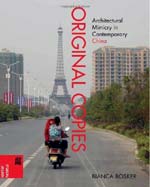
|

|
|
Home Site Search Contact Us Subscribe
|
|
|
Book Review: "Original Copies, Architectural Mimicry in Contemporary China" by Bianca Bosker A must-have for those who wish to see a design phenomenon and trend explained in a clear and concise manner without the pretentious tribal signifiers that so plague academic writers. By Christian Bjone April 4, 2013 Written by Bianca Bosker, a tireless journalist/blogger for Huffington Post, her Original Copies, Architectural Mimicry in Contemporary China (University Of Hawai'i Press, 2013) is produced in the best newspaper three-point formula: first, state your theme; second, explain your theme; and last, remind everyone of what you have just written. This creates a language more accessible then most architect-speak volumes, but creates a certain amount of needless repetition.
Bosker concentrates mostly on the New Chinese Theme-Park luxury housing estates duplicating exactly the exterior features of Swiss hill towns, French Parisian districts, California Beverly Hills, and British garden suburbs, advertised with such names as Top Aristocrat (Beijing), Eaton Town (Suzhou), Garden of Monet (Shanghai), and my favorite, Galaxy Dante (Shenzhen). The most dramatic image of these gated communities is a reproduction of the Eiffel Tower at 108 meters tall, making it one-third the original’s height, for the housing development named Oriental Paris in the Yangtze River Delta. This is, of course, just down the road from another big copy of the Apollo fountain from the Palace of Versailles. Bosker collects these developments under the catch-all title “Simulacrascapes.”
The book can be summed up in one quote by the author: “The Chinese housing industry has rewritten the capitalist real estate mantra, ‘location, location, location’ into the motto ‘replication, replication, replication.’”
If these towns were built in the old Soviet Union, the ominous assumption would be that they were training camps for a future European invasion. But by being in China, they are so dislocated from the existing culture that the first reaction by a Westerner is confusion followed by derision and then by fascination. It is, after all, a perfect mirror to our own Occidental material obsessions and lifestyle neuroses distorted by a new Asian global power elite.
The major theme, as you can guess by the word “Original” in the title Original Copies, is that to the author, this is not just mindless appropriation but a cultural phenomenon that finds origins in ancient Chinese traditions. Bosker notes: “The ability to render a good copy has, historically, been taken by the Chinese as a marker of technological and cultural superiority, and the coexistence of an original and its virtually indistinguishable double does not trigger the ontological crisis that is characteristic of the West.” Therefore, Chinese real estate developers are seemingly justified in using Western architectural design because this is aspiring to status signifiers in an elaborate marketing program to the new upper classes.
As a journalist Bosker truly has not a mean bone in her body as she reviews even more audacious appropriations. To keep her calm neutrality she avoids any cultural criticism (except perhaps on the ecological consequences of suburban sprawl), and leaves as an open question the sometimes blatant greed and intellectual sloth that these projects demonstrate.
Unfortunately it is only in the last chapter that contemporary design in China is reviewed. And the publication means the book missed the current Internet controversy about the duplication of Zaha Hadid’s curvilinear office building complex Wangjing SOHO in Beijing, which is being repeated without permission, by another architect, in another Chinese city, Chongqing. The Chinese copyright infringement economy has now moved from amusing to threatening, and with direct monetary consequences, similar to Western computer technology, to many Western architects working in Asia.
Original Copies is thoroughly researched and a must-have for those who travel or work in China, and all others who wish to see a design phenomenon and trend explained in a clear and concise manner without the pretentious tribal signifiers that so plague academic writers.
Christian Bjone is an architect in New York City. His third book, Philip Johnson and His Mischief, appropriation in art and architecture, will be out in July 2013, issued by Images Publishing.
|
(click on pictures to enlarge) 
|
© 2013 ArchNewsNow.com